Here at LSOZI, we take off every Wednesday for a look at the old steam/diesel navies of the 1833-1954 period and will profile a different ship each week. These ships have a life, a tale all their own, which sometimes takes them to the strangest places.- Christopher Eger
Warship Wednesday, April 10, 2024: Mongolia by way of Massachusetts

Photo by Geo. H. Russell. Library of Congress, Box PAN US Military-Army No.92 (E size). Control number 2007664426
Above we see, 105 years ago today (10 April 1919) the well-armed troopship USS Mongolia (ID 1615) arriving at Boston with the returning hometown boys of the 26th “Yankee” Division aboard.
Don’t let her passenger liner appearance fool you, she was a fighter and had the honor of the first surface engagement between U.S. Naval personnel and sailors of the Kaiserliche Marine.
The Beautiful Twins of the Pacific Mail Steamship Co.
Founded in 1848 originally to service the Panama Route across the isthmus during the California Gold Rush, the Pacific Mail Steamship Company had flown its red, white, and blue house flag from more than 60 passenger steamers before the 19th Century was out.
While the majority of these were smallish (2,000-3,000 ton) coastwise vessels, by the late 1890s the company had ordered four progressively larger liners– SS China (10,200 tons), SS Nile (11,000 tons), SS Korea (18,000 tons), and SS Siberia (18,500 tons)– to build its reputation and expand its reach across the Pacific, kicking off its Trans-Pacific service.
By 1901, it moved to pick up two new liners– SS Mongolia and SS Manchuria— that would be its crown jewels.
The sister ships, ordered from the nascent New York Shipbuilding Co in Camden, were huge for their era at 615 feet oal with a registered gross tonnage of 13,363 tons. They could carry 1,712 passengers in four different classes, with speeds sustained at 16 knots, intended for cruises from San Francisco to ports in China and Japan, with a midway stop in Hawaii. The service was later extended to Hong Kong and Manila.
At the time, they were the largest passenger vessels constructed in America, with class leader Mongolia delivered in February 1904.


“Speed and Comfort” Pacific Mail Steamship Co. poster with artwork by Fred Pansing, showing Mongolia and citing the names of her fellow Trans-Pacific line vessels. LOC LC-DIG-ppmsca-58680

S.S. Mongolia at Manila, Philippine Islands, in 1913. U.S. Naval History and Heritage Command Photograph. NH 45962
By August 1915, with a downturn in Pacific sailings, both Mongolia and sister Manchuria, along with the smaller Korea and Siberia, were sold to the Baltimore-based Atlantic Transport Line and soon began working from the East Coast.
As a war was going on in the Atlantic (ATL had already lost several of its ships to government requisition and U-boats), Mongolia made nine wartime crossings while the U.S. was neutral, carrying munitions and foodstuffs to a hungry England.
In this role, she had “American S. S. Mongolia” painted in large white letters along the sides of her hull flanked by American flags.
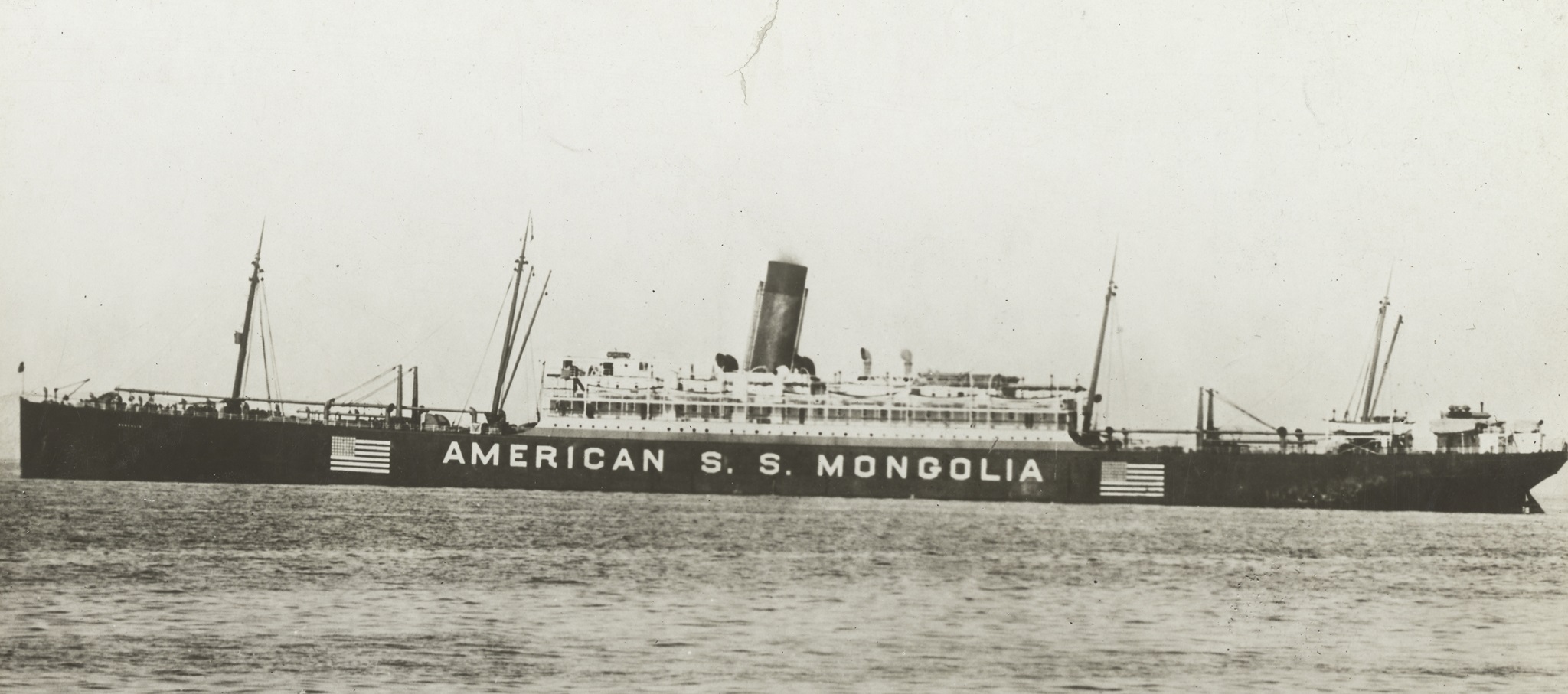
S.S. Mongolia, painted with neutrality markings, circa 1915-1917. 165-WW-274A-004
War!
On March 13, 1917– still three weeks away from the U.S. declaration of war, Secretary of the Navy Josephus “Cup of Joe” Daniels issued regs governing the conduct of armed American merchant vessels, on which Navy personnel designated as Armed Guards manned the guns. The Bureau of Ordnance would follow up on the directive and issue guidance to the fleet for the removal of 20 5-inch/51-caliber; 20 6-inch/40-caliber; 4 5-inch/50-caliber; and 26 3-inch/50-caliber guns from storage and warships in reserve for use on merchant men.
Talk about armed neutrality!
The first to be armed would be the passenger liners Manchuria, Mongolia, and St. Louis; along with the steamships New York, Philadelphia, Kroonland, Aztec, and St. Paul.
Just two days after the SECNAV’s orders, the New York Navy Yard completed the installation of deck guns aboard Manchuria, St. Louis, Aztec, and New York, and on the 16th of March, Manchuria— outfitted with two 4-inch guns forward, one 6-inch gun aft, two 1-pounders, and two Lewis guns– left NYC to become the first American armed merchantman to sail for the European war zone.
Mongolia would receive three 6″/40 Mark 4s, two forward and one over her stern, and later add two additional mounts, giving her a total of five of these large guns– the rough equivalent of a light cruiser. Her initial Armed Guard, consisting of one officer (Massachusetts-born LT Bruce Richardson Ware, Jr., USNA ’07) and 22 enlisted (a size that would later double), likewise carried sidearms and had a locker of rifles and a pair of Lewis guns at their disposal as well.
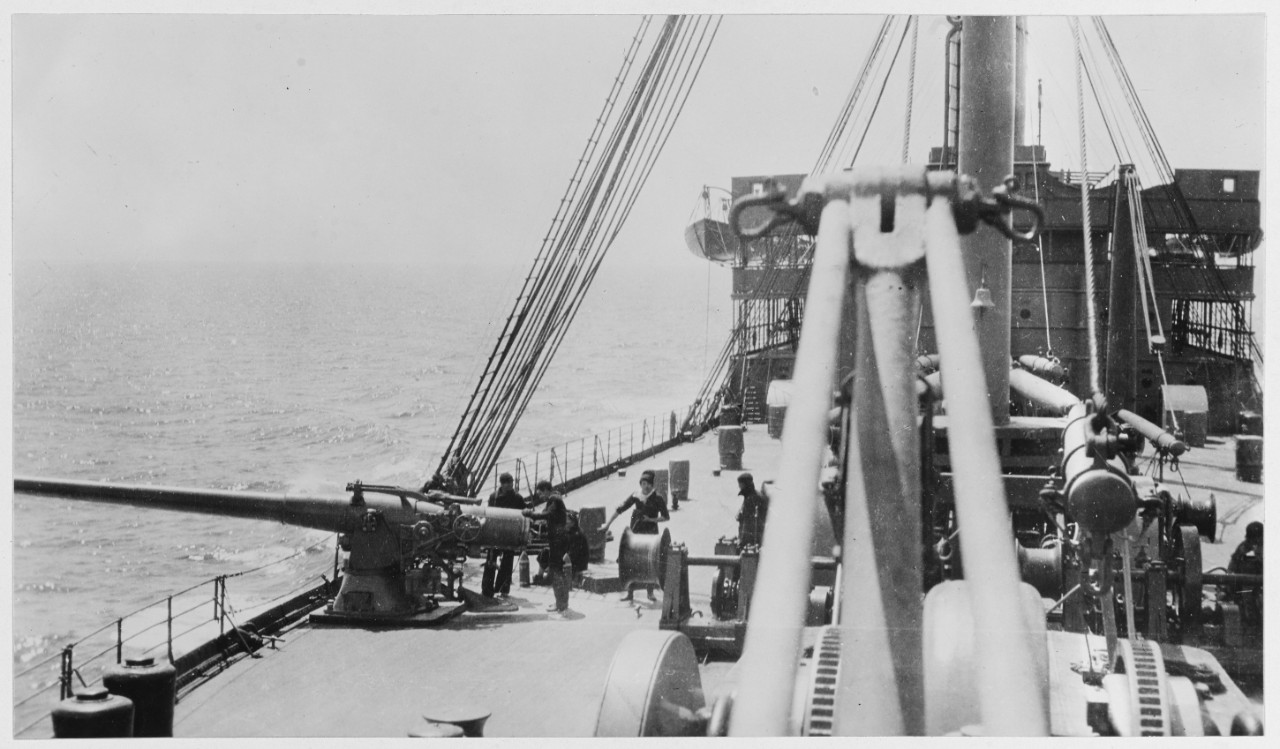
S.S. Mongolia. One of the ship’s forward six-inch guns, taken while Mongolia was at sea in April 1917. These guns were manned by Armed Guard crews supplied by the U.S. Navy. NH 41973

Mongolia, 1917. Note 6″/40 on stern. 165-WW-335D-021
Mongolia would make history on the early morning of 19 April– the Anniversary of the Battle of Lexington– when, at 0522, the Armed Guard aboard her engaged and drove off a U-boat with their stern 6-inch gun—No. 263, nicknamed “Teddy Roosevelt”—while some 7 miles southeast of Beachy Head in the English Channel. She fired on the submarine, wrecking the periscope and conning tower, and forced it to submerge. These are considered the first shots by the U.S. Navy against Germany in the Atlantic.

S.S. Mongolia. Two officers on board the ship soon after her 19 April 1917 action with a German submarine. They are identified in the original photo captions as Lieutenant Charles F. (or Bruce R.) Ware, USN, and First Officer Waldo E. Wollaston (or Mollaston). Note the right-hand officer’s high boots, communications gear, and .45 caliber M1911 pistol; binoculars worn by both; and non-U.S. Navy insignia on the left-hand officer’s cap. NH 52704

USS Mongolia. The ship’s after six-inch gun, with several shells, circa 1918. This gun was nicknamed Teddy, after former President Theodore Roosevelt. The original image is printed on postcard (AZO) stock. Donation of Dr. Mark Kulikowski, 2009. NH 106599
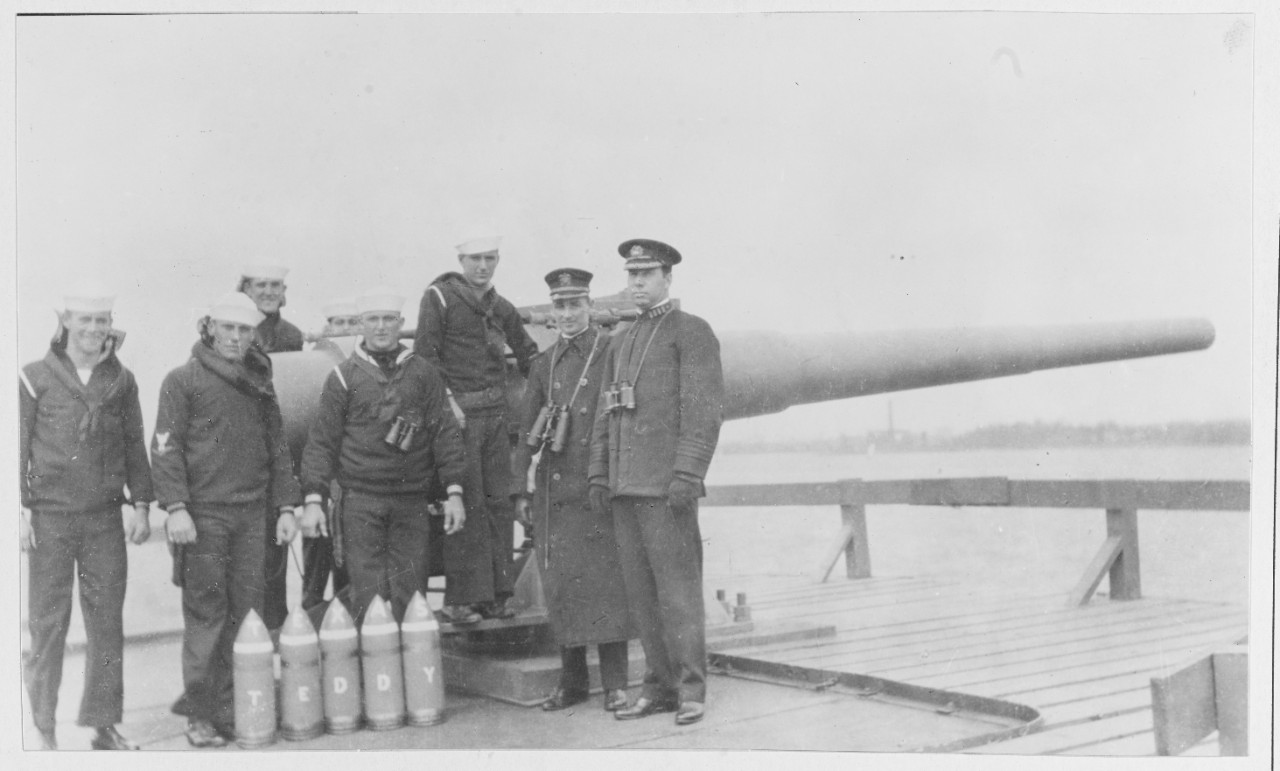
S.S. Mongolia. The ship’s after six-inch gun and its crew, April 1917. The two officers at right are identified, in the original photo caption, as Lieutenant Ware and Captain Emory Rice of the U.S. Naval Reserve Force. Note shells on deck, painted with letters: T-E-X-A-S and T-E-D-D-Y. NH 781
The news was electric and widely reported on both sides of the Atlantic, eventually passing into the post-war record.
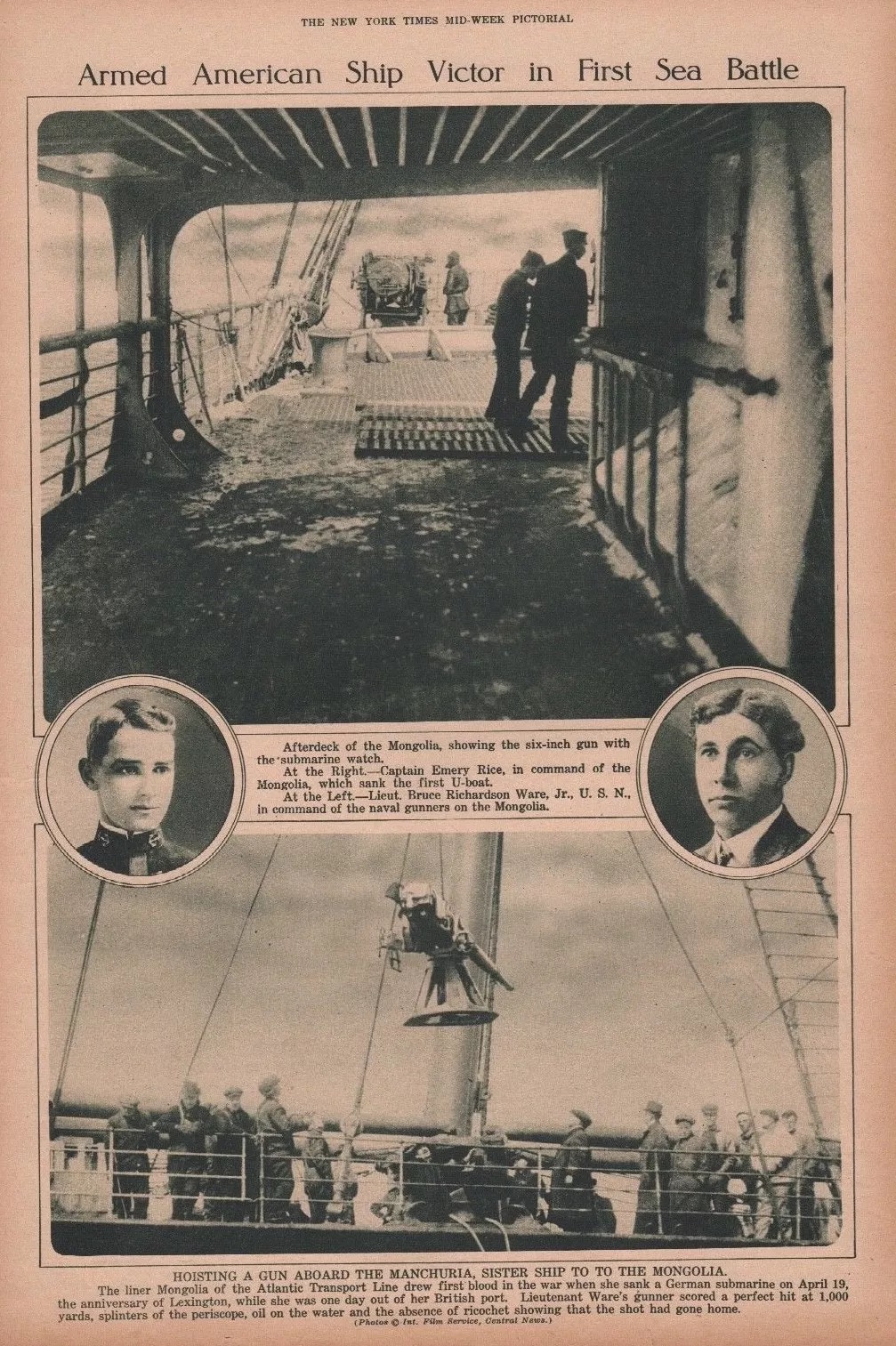
The engagement was the subject of an art piece by Joseph Christian Leyendecker, used widely in reference to the Mongolia vs U-boat fight, with the gunners, in Leyendecker fashion, shirtless.

As noted by press accounts of interviews given by the ship’s skipper, Capt. Emery Rice:
“It was twenty-two after five o’clock in the morning of the 19th that we sighted the submarine. The officer commanding the gunners was with me on the bridge where, in fact, we had been the most time throughout the voyage.” Captain Rice continues, “There was a haze over the sea at the time. We had just taken a sounding for we were getting near shallow water, and we were looking at the lead when the first mate cried: “My God, there’s a submarine off the port bow!”
“The submarine was close to us, too close in fact for her purpose, and the boat was submerging again in order to maneuver into a better position for torpedoing was where we sighted her.” Rice continues “We saw the periscope go down and the swirl of the water. I quickly ordered the man at the wheel to put her to starboard and we swung the nose of the ship toward the spot where the submarine had been.”
“We were going at full speed ahead and two minutes after we first sighted the U-boat it emerged again about 1,000 yards off. Its intention probably had been to catch us broadside, but when it appeared he had the stern gun trained full on it. The gun crew commander, Lieutenant Ware gave the command “1,000 yards, Scale 50” and the big gun boomed. Gunner’s Mate James A. Goodwin was on the gun at the time, and he actually fired the shell that hit the U-boat. We saw the periscope shatter and tumble end over end across the water and the submarine disappeared. I can’t speak too highly of the cool manner in which the lieutenant handled his crew of gunners. It was a fine exhibition of the efficiency of American Naval men.” The whole encounter lasted only about two minutes. Lt. Ware gave the order to fire, and Gunner’s mate Goodwin pulled the lanyard firing the first shot, which missed. Reloading quickly, the gun crew fired again, and this time they were right on target hitting the conning tower of the U-boat. This shell exploded and hit the area of the conning tower. Quickly in a foamy froth of bubbles, the German slipped beneath the sea. America had just inflicted its first blood at sea against Germany, and it was over as quickly as it had started.
Captain Rice continues, “I assure you we did not stop after the incident, but steamed away at full speed, for it was not improbable that there was another submarine about. The one I got undoubtedly had been lying on the bottom at the spot waiting for the ship and came up when it heard our propellers. I immediately sent a wireless stating that a submarine had been seen.” Rice ended his statement with this “That’s about all the story except this. The gunners had named the guns on board the Mongolia and the one which got the submarine was called “Teddy” after Theodore Roosevelt; so Teddy fired the first gun of the war after all.” Captain Rice stated that Teddy Roosevelt was from Allison, Massachusetts, and that the encounter with the submarine occurred on the date when Massachusetts was celebrating the anniversary of the Battle of Lexington.
Ware’s version was less verbose:
We were just leaving New York Harbor when word reached us that Congress had declared war. On the way over we had daily gun practice and some ill luck with our 6-inch fixed ammunition. By the time we reached the submarine zone, our two bow guns had damaged bores and were not firing true. It was at dawn on the morning of the 19th of April, the anniversary of the Battle of Lexington, that we sighted the U-boat coming at us off the bow. Realizing that our forward guns were unreliable, we swung the Mongolia hard to starboard. The submarine, delighted to see us offering a broadside target for its torpedo, also swung around, coming into the range of our port guns. Our first shot caught the sub square on the conning tower beneath the periscope. There was a splash and when the water cleared away, there was no more submarine.
Post-war analysis doesn’t show a U-boat lost in these waters at the time Mongolia reported the incident, but it is posed by some that the boat involved may have been S.M. UB 40, an extremely successful member of the Flandern Flotilla, which reported taking gunfire in the same area without significant damage around this time.
Both Ware and Rice (who was sheep-dipped as a USNRF officer) were soon issued the Navy Cross.
While widely celebrated, the Armed Guards on Mongolia received what was possibly more press coverage due to an accident that occurred on a later voyage the following month.
On 20 May 1918 while just a few hours out of New York, while conducting target practice with the famed Teddy, an accident occurred that left a group of Red Cross nurses crossing over to France, who were observing the crew at work, with two dead and a third injured.
As noted by the SECNAV’s office at the time:
When about 100 miles to sea, in accordance with the usual procedure, guns were fired to test mounts, ammunition, and to practice the navy crew in their use. The guns were of the 6-inch caliber for which the shell and powder are loaded separately into the gun. The powder charge is contained in a brass case and there held in place by a pasteboard wad, distance pieces, and a brass mouth cup that fits closely, thus making a moisture-tight joint in order that the powder may always give the velocity and pressure intended. When the gun is fired this brass cup is propelled some distance, sometimes whole and sometimes in pieces, but always in front of the gun. Several nurses who were watching the firing were sitting on the promenade deck some 175 feet abaft and 10 feet above the gun. On the third shot the brass mouth cup struck the water peculiarly, boomeranged directly back to the ship, struck the stanchion near where the nurses were sitting and broke. Its pieces instantly killed Mrs. Edith Ayres and Miss Helen Burnett Wood, of Chicago

“Miss Helen B. Wood, the Chicago Red Cross nurse who was instantly killed in a gun accident while the gun crew of the armed American liner Mongolia was at target practice at sea,” followed by ARC photo of Miss Edith Ayres. Signal Corps 165-WW-55B-84 via NARA/LOC LC-A6195- 4962
For what it is worth, later Congressional hearings into the incident charged that the fuzes involved were of “inferior workmanship” and that the Navy had not inspected them before accepting them from the Raleigh Iron Works, which was in the midst of rushed war work. In the hearings, the makers of the fuzes rebutted the charge and the whole thing was written off as a terrible, but freak, accident.
Mongolia and her guard, then under one LT Philip Seymour, would, on 1 June 1917, engage another U-boat in a surface action. As noted in Seymour’s Navy Cross citation, the “enemy submarine fired a torpedo at that vessel, which through quick maneuvering missed the ship. Four shots were fired at the periscope when the submarine disappeared.”
On 9 April 1918, SECNAV Daniels announced that seven Army-run War Department transports and store ships—Finland (ID-4543), Pastores (ID-4540/AF-16), Tenadores, Henry R. Mallory (ID-1280), Lenape (ID-2700), Mongolia (ID-1615), and Manchuria (ID-1633)—were to be taken over by the Navy.
This led USS Mongolia to be commissioned in the Navy on 8 May 1918, with CDR E. McDowell in command. She went on to make 13 cross-Atlantic voyages from the U.S. to France, transporting over 33,000 troops, before decommissioning on 11 September 1919 for return to her owner. Likewise, her sistership Manchuria had bested that number, carrying 39,000 troops in 13 round trips to Europe (nine of them after the Armistice).

World War I Troop Transport Convoy at Sea, 1918. The most distant ship, in the left center, is the USS Mongolia (ID # 1615). The nearer ship, misidentified on the original print as USS Mercury (ID # 3012), is USS Madawaska (ID # 3011). Note the small destroyer ahead of the forward ship. Photographed by V.J.M. Donation of Charles R. Haberlein Jr., 2008. NH 106288

USS Mongolia (ID # 1615) At the New York Navy Yard, 28 June 1918, after being painted in pattern camouflage. NH 50252

USS Mongolia (ID # 1651) In port, while painted in dazzle camouflage, circa 1918. Donation of Dr. Mark Kulikowski, 2008. NH 105722

Nurses of Mobile Hospital #39, onboard Mongolia. A.T.S. Base Section #1. St. Nazaire Jan. 20. 1919 111-SC-46348
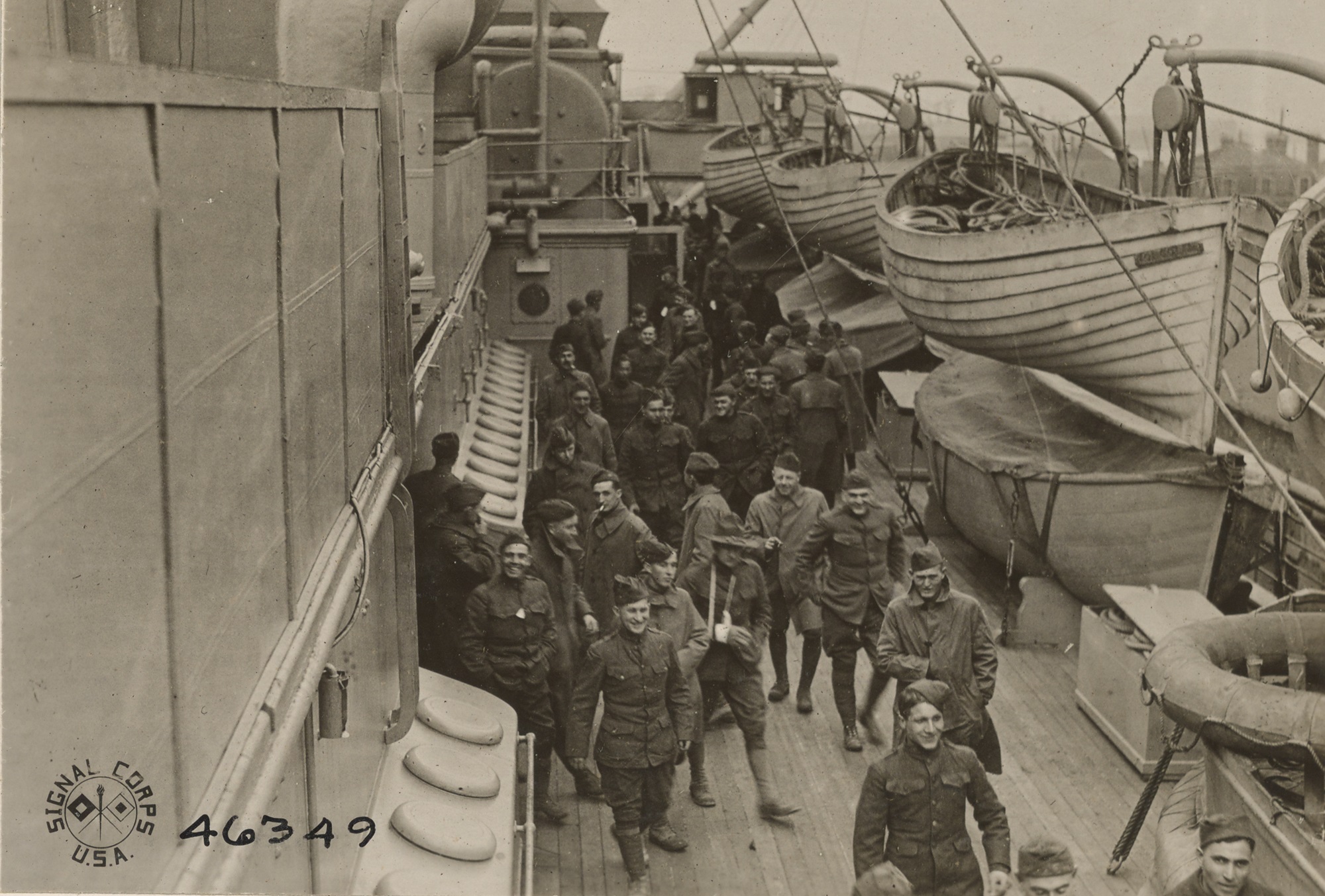
Homeward-bound troops taking their afternoon walk. St. Nazaire, Jan. 20 1919 111-SC-46349

USS Mongolia. Brest, 1919 111-SC-158226_001

102nd Artillery 26th Division loading on the Mongolia. Brest 3.31.19 111-SC-158223_001
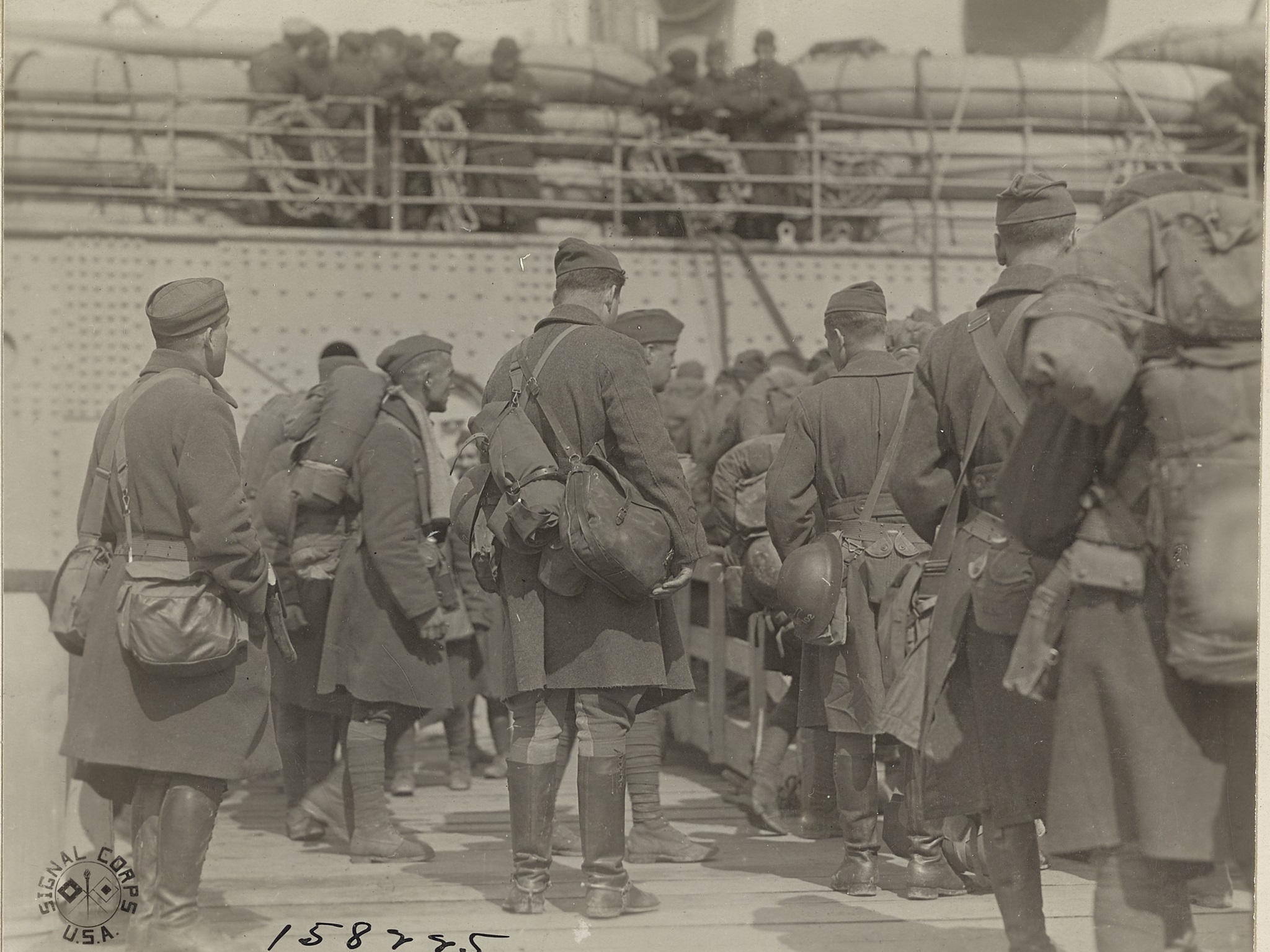
103rd Artillery, 26th Division loading on the S. S. Mongolia. Brest, Finistere, France 3.31.19 111-SC-158225_001

LC-DIG-ggbain-23572
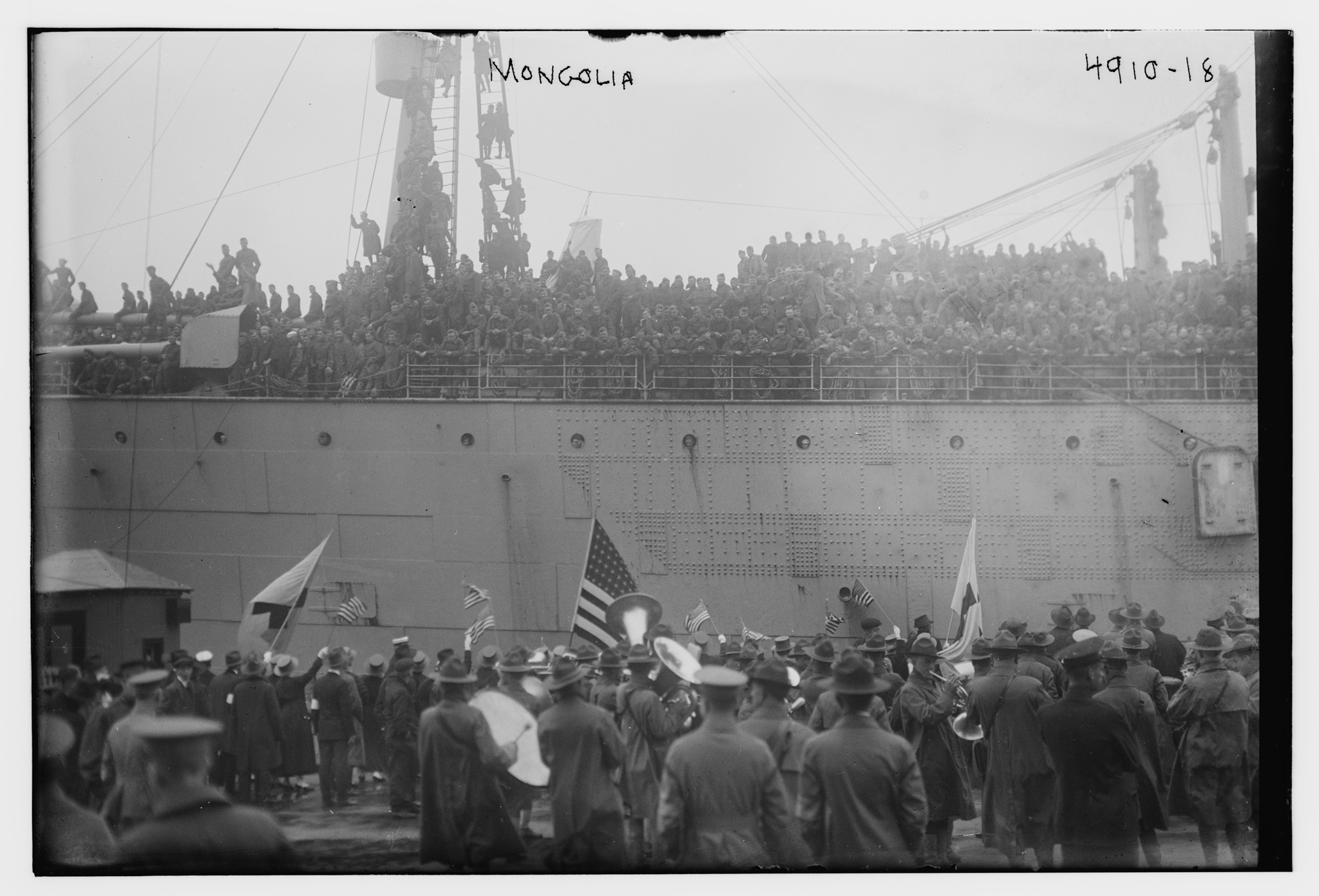
With troops aboard. Note her 6″/40. LC-DIG-ggbain-28781
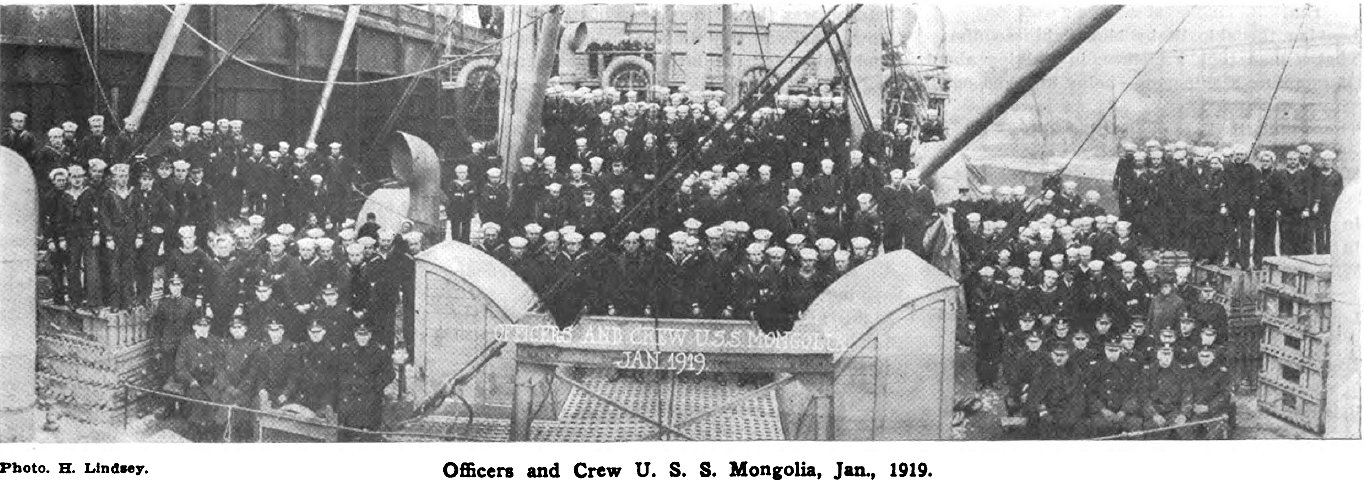
Officers and men of Mongolia

Camouflaged U.S. Navy transport in harbor with barge and a passenger ferry alongside, circa 1918 or very early 1919. This ship is probably the USS Mongolia (ID # 1615). Donation of Charles R. Haberlein Jr., 2009. NH 106646
Returning to Trade
Post Versailles, Mongolia and Manchuria went to be operated by the rebooted New York‑Hamburg steamship line, making regular trips to Weimar-era Germany.

SS Mongolia at the St. Pauli Landing Stage, Hamburg, Germany, while in commercial service after World War I. Donation of Captain Stephen S. Roberts, USNR (Retired), 2008. NH 105919
Re-acquired by the Panama Pacific Lines in 1925, within a few years she was under the flag of the Dollar Steam Ship Lines then in 1938, under the ownership of the American President Lines, was renamed SS President Fillmore.

Mongolia in Gaillard Cut March 17, 1926 185-G-1094
During the first days of WWII, she was sold to Wallam & Co. on 2 February 1940 and would sail for Cia Transatlantica Centroamericana under the Panamanian flag named (wait for it) SS Panamanian, and would carry commercial cargo through the conflict, managing to avoid further U-boat activity.
After suffering a fire at Freemantle’s North Quay while carrying a 10,000-ton cargo of flour in January 1945, she was scrapped at Shanghai in 1946.
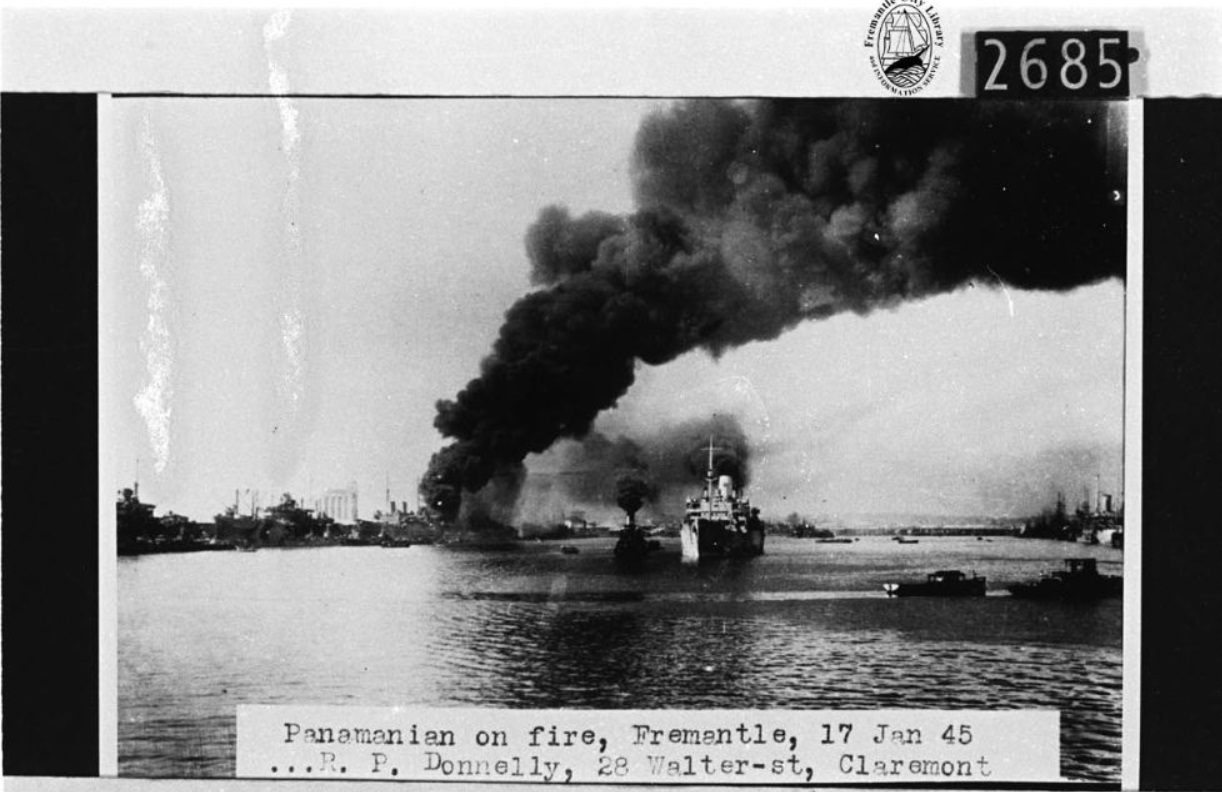
As for her sister Manchuria, she had a similar interbellum history but, as the American-flagged President Line’s SS President Johnson, was requisitioned by the War Shipping Administration in 1941 and carried troops throughout the Pacific during WWII.

Sold post-war to a Panamanian firm, she continued sailing as SS Santa Cruz, typically carrying European war refugees to South America, and was scrapped in 1952.
Epilogue
Mongolia’s naval plans are in the National Archives, as are her USS and USAT deck logs.
One of her 6″40s, No. 155, is preserved at Gosport Park, in Portsmouth, Virginia.



Speaking of Mongolia’s Armed Guard, Ware, its Navy Cross-wearing commander, went on to become an instructor at the Naval Academy then, after passing through the Naval War College program and later the Army War College, would become the XO of the transport USS Gold Star in the 1920s and then filled the same billet on the dreadnought USS West Virginia— during which the battlewagon was first in gunnery in the fleet. He also published extensively.
Retiring from the Navy as a captain in 1935, he passed in San Diego and is buried at Fort Rosecrans National Cemetery.

Mongolia is well remembered in period maritime art and postcards.

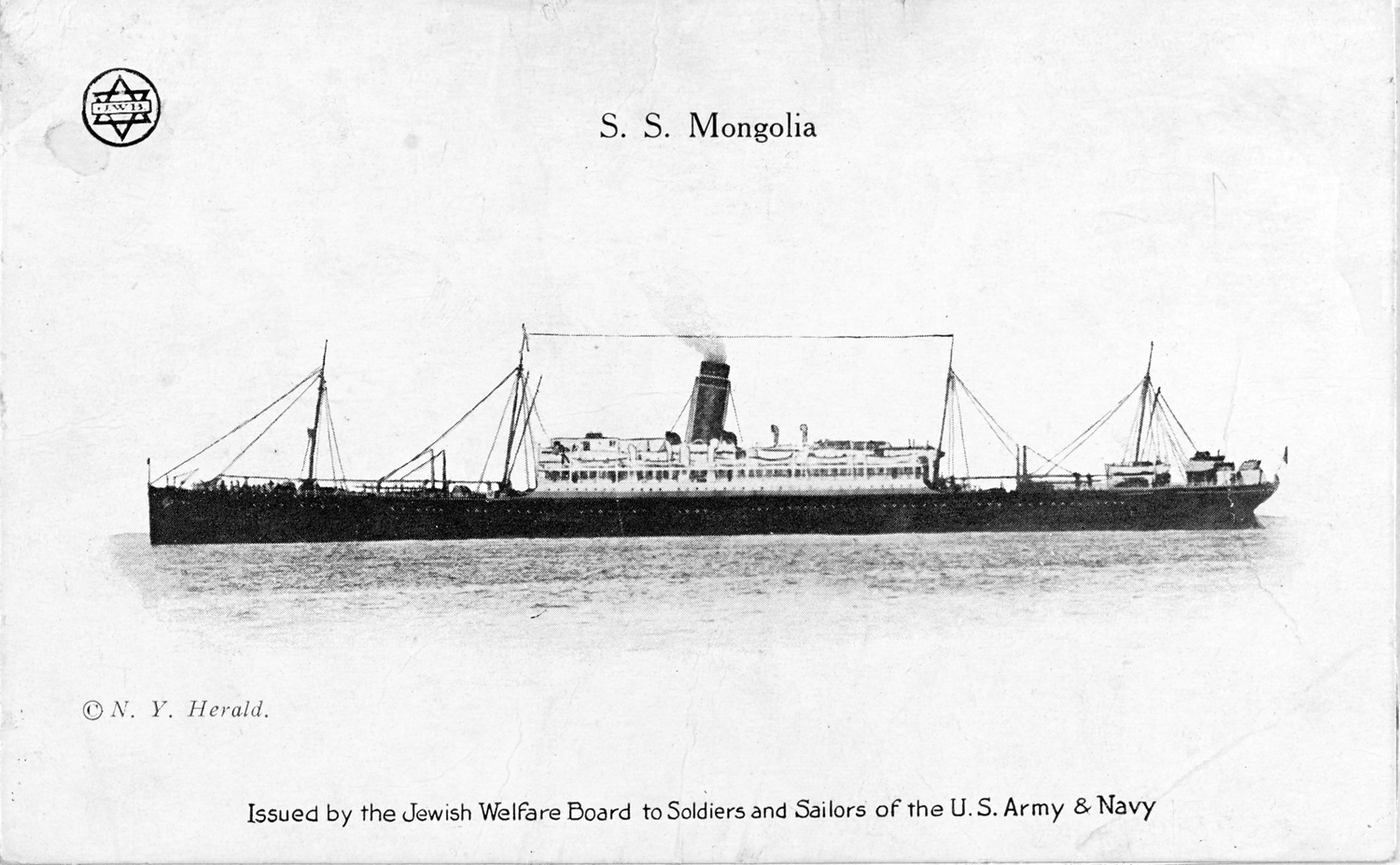
S.S. Mongolia artwork, printed on a postal card issued by the Jewish Welfare Board to Soldiers and Sailors of the U.S. Army & Navy, during World War I. NH 45961
Ships are more than steel
and wood
And heart of burning coal,
For those who sail upon
them know
That some ships have a
soul.
If you liked this column, please consider joining the International Naval Research Organization (INRO), Publishers of Warship International
They are one of the best sources of naval study, images, and fellowship you can find. http://www.warship.org/membership.htm
The International Naval Research Organization is a non-profit corporation dedicated to the encouragement of the study of naval vessels and their histories, principally in the era of iron and steel warships (about 1860 to date). Its purpose is to provide information and a means of contact for those interested in warships.
With more than 50 years of scholarship, Warship International, the written tome of the INRO has published hundreds of articles, most of which are unique in their sweep and subject.
PRINT still has its place. If you LOVE warships you should belong.
I am a member, so should you be!



































































